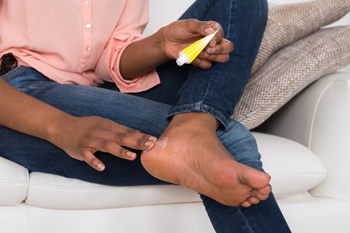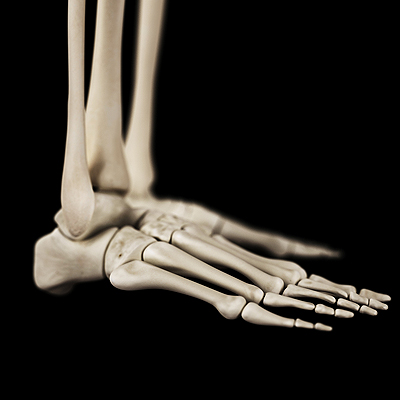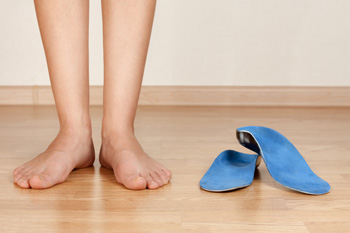Connect With Us
Items filtered by date: December 2020
Do Your Child's Feet Hurt?
What to Look for in Orthotics
Orthotics are special shoe inserts designed to give your feet support and make standing, walking, and other daily activities more comfortable. Orthotics can be bought in most major drug stores, or they can be prescribed and custom made by a podiatrist. When looking for orthotic inserts, it is important to consider your needs. For example, if you experience foot pain due to prolonged standing, you may want to look for orthotics that have extra cushioning. If you participate in sports that require you to frequently put weight on the balls of your feet, such as running, look for inserts that support the metatarsal arch at the front of the foot. If you suffer from heel pain, it suggested that your orthotics offer extra shock absorption in the heel area and have firm arch support. To learn more about orthotics and which ones may be right for you, please consult with a podiatrist.
If you are having discomfort in your feet and would like to try orthotics, contact one of our podiatrists from The Podiatry Center, PC. Our doctors can provide the care you need to keep you pain-free and on your feet.
What Are Orthotics?
Orthotics are inserts you can place into your shoes to help with a variety of foot problems such as flat feet or foot pain. Orthotics provide relief and comfort for minor foot and heel pain but can’t correct serious biomechanical problems in your feet.
Over-the-Counter Inserts
Orthotics come in a wide variety of over-the-counter inserts that are used to treat foot pain, heel pain, and minor problems. For example, arch supports can be inserted into your shoes to help correct overarched or flat feet, while gel insoles are often used because they provide comfort and relief from foot and heel pain by alleviating pressure.
Prescription Orthotics
If over-the-counter inserts don’t work for you or if you have a more severe foot concern, it is possible to have your podiatrist prescribe custom orthotics. These high-quality inserts are designed to treat problems such as abnormal motion, plantar fasciitis, and severe forms of heel pain. They can even be used to help patients suffering from diabetes by treating foot ulcers and painful calluses and are usually molded to your feet individually, which allows them to provide full support and comfort.
If you are experiencing minor to severe foot or heel pain, it’s recommended to speak with your podiatrist about the possibilities of using orthotics. A podiatrist can determine which type of orthotic is right for you and allow you to take the first steps towards being pain-free.
If you have any questions please contact our office located in Millburn, NJ . We offer the newest diagnostic and treatment technologies for all your foot and ankle needs.
Easing the Pain of Cracked Heels
 Wearing certain shoes may caused cracked heels. Flips flops are generally included in this category, and can cause the skin on the heels to become dry. This may lead to fissures forming, which can become painful and uncomfortable. It is beneficial to start treating cracked heels as quickly as possible, as this may help to prevent fissures, bleeding and infection. Effective treatment methods can begin with removing the dry skin from your heels. This can be done by using a pumice stone, followed by applying a good moisturizer on the affected area. It can help to drink plenty of fresh water daily, and walking instead of running may help to alleviate some of the pressure on the feet, which may contribute to cracked heels. If your cracked heels are severe and do not heal through home treatment, it is recommended that you consult with a podiatrist who can offer you additional treatment options.
Wearing certain shoes may caused cracked heels. Flips flops are generally included in this category, and can cause the skin on the heels to become dry. This may lead to fissures forming, which can become painful and uncomfortable. It is beneficial to start treating cracked heels as quickly as possible, as this may help to prevent fissures, bleeding and infection. Effective treatment methods can begin with removing the dry skin from your heels. This can be done by using a pumice stone, followed by applying a good moisturizer on the affected area. It can help to drink plenty of fresh water daily, and walking instead of running may help to alleviate some of the pressure on the feet, which may contribute to cracked heels. If your cracked heels are severe and do not heal through home treatment, it is recommended that you consult with a podiatrist who can offer you additional treatment options.
If the skin on your feet starts to crack, you may want to see a podiatrist to find treatment. If you have any concerns, contact one of our podiatrists from The Podiatry Center, PC. Our doctors can provide the care you need to keep you pain-free and on your feet.
Cracked Heels
It is important to moisturize your cracked heels in order to prevent pain, bleeding, and infection. The reason cracked heels form is because the skin on the foot is too dry to support the immense pressure placed on them. When the foot expands, the dry skin on the foot begins to split.
Ways to Help Heal Them
- Invest in a good foot cream
- Try Using Petroleum Jelly
- Ease up on Soaps
- Drink Plenty of Water
Ways to Prevent Cracked Heels
- Moisturize After Showering
- Skip a Shower
- Keep Shower Water Lukewarm
- Don’t Scrub Your Feet
If you are unsure how to proceed in treating cracked heels, seek guidance from a podiatrist. Your doctor will help you with any questions or information you may need.
If you have any questions, please feel free to contact our office located in Millburn, NJ . We offer the newest diagnostic and treatment technologies for all your foot care needs.
Wounds That Don't Heal Need to Be Checked
What Causes Gout?
 Gout is a condition characterized by acute pain and inflammation in the joints that is caused by a buildup of uric acid. The joints of the feet, and especially the joint at the base of the big toe, are frequently affected. Symptoms of gout include sudden severe pain in one or more joints, skin discoloration, warmth, and swelling over the affected area, chills, fever, and a general feeling of illness. The buildup of uric acid that causes gout symptoms to develop may be due to the body producing too much uric acid. Another factor may be the kidneys not being able to get rid of enough uric acid, or from eating foods high in purines, which get converted to uric acid in the body. Gout attacks can be triggered by drinking alcohol, eating a lot of protein-rich foods, emotional stress, fatigue, illness, and minor surgery. For more information about gout, consult with a podiatrist today.
Gout is a condition characterized by acute pain and inflammation in the joints that is caused by a buildup of uric acid. The joints of the feet, and especially the joint at the base of the big toe, are frequently affected. Symptoms of gout include sudden severe pain in one or more joints, skin discoloration, warmth, and swelling over the affected area, chills, fever, and a general feeling of illness. The buildup of uric acid that causes gout symptoms to develop may be due to the body producing too much uric acid. Another factor may be the kidneys not being able to get rid of enough uric acid, or from eating foods high in purines, which get converted to uric acid in the body. Gout attacks can be triggered by drinking alcohol, eating a lot of protein-rich foods, emotional stress, fatigue, illness, and minor surgery. For more information about gout, consult with a podiatrist today.
Gout is a foot condition that requires certain treatment and care. If you are seeking treatment, contact one of our podiatrists from The Podiatry Center, PC. Our doctors will treat your foot and ankle needs.
What Is Gout?
Gout is a type of arthritis caused by a buildup of uric acid in the bloodstream. It often develops in the foot, especially the big toe area, although it can manifest in other parts of the body as well. Gout can make walking and standing very painful and is especially common in diabetics and the obese.
People typically get gout because of a poor diet. Genetic predisposition is also a factor. The children of parents who have had gout frequently have a chance of developing it themselves.
Gout can easily be identified by redness and inflammation of the big toe and the surrounding areas of the foot. Other symptoms include extreme fatigue, joint pain, and running high fevers. Sometimes corticosteroid drugs can be prescribed to treat gout, but the best way to combat this disease is to get more exercise and eat a better diet.
If you have any questions please feel free to contact our office located in Millburn, NJ . We offer the newest diagnostic and treatment technologies for all your foot and ankle needs.
Signs of Cuboid Syndrome
 Cuboid syndrome is also referred to as cuboid subluxation. It affects the cuboid bone, which is one of seven tarsal bones that are located in the back and middle area of the foot. This ailment can occur after the patient has endured an ankle injury, or it may happen gradually from overuse. Common symptoms that are generally experienced can include pain and discomfort on the outside of the ankle, and it is often difficult to walk. Additionally, the affected area may appear swollen, and there may be noticeable overpronation. The joint may be manipulated back into its correct position, and wearing orthotics can help to support the arch. If you have foot pain, it is strongly recommended that you seek the counsel of a podiatrist who can properly diagnose and treat cuboid syndrome.
Cuboid syndrome is also referred to as cuboid subluxation. It affects the cuboid bone, which is one of seven tarsal bones that are located in the back and middle area of the foot. This ailment can occur after the patient has endured an ankle injury, or it may happen gradually from overuse. Common symptoms that are generally experienced can include pain and discomfort on the outside of the ankle, and it is often difficult to walk. Additionally, the affected area may appear swollen, and there may be noticeable overpronation. The joint may be manipulated back into its correct position, and wearing orthotics can help to support the arch. If you have foot pain, it is strongly recommended that you seek the counsel of a podiatrist who can properly diagnose and treat cuboid syndrome.
Cuboid syndrome, also known as cuboid subluxation, occurs when the joints and ligaments near the cuboid bone in the foot become torn. If you have cuboid syndrome, consult with one of our podiatrists from The Podiatry Center, PC. Our doctors will assess your condition and provide you with quality foot and ankle treatment.
Cuboid syndrome is a common cause of lateral foot pain, which is pain on the outside of the foot. The condition may happen suddenly due to an ankle sprain, or it may develop slowly overtime from repetitive tension through the bone and surrounding structures.
Causes
The most common causes of cuboid syndrome include:
- Injury – The most common cause of this ailment is an ankle sprain.
- Repetitive Strain – Tension placed through the peroneus longus muscle from repetitive activities such as jumping and running may cause excessive traction on the bone causing it to sublux.
- Altered Foot Biomechanics – Most people suffering from cuboid subluxation have flat feet.
Symptoms
A common symptom of cuboid syndrome is pain along the outside of the foot which can be felt in the ankle and toes. This pain may create walking difficulties and may cause those with the condition to walk with a limp.
Diagnosis
Diagnosis of cuboid syndrome is often difficult, and it is often misdiagnosed. X-rays, MRIs and CT scans often fail to properly show the cuboid subluxation. Although there isn’t a specific test used to diagnose cuboid syndrome, your podiatrist will usually check if pain is felt while pressing firmly on the cuboid bone of your foot.
Treatment
Just as the range of causes varies widely, so do treatments. Some more common treatments are ice therapy, rest, exercise, taping, and orthotics.
If you have any questions, please feel free to contact our office located in Millburn, NJ . We offer the newest diagnostic and treatment technologies for all your foot care needs.
It's Time for Beautiful Feet
Blog Archives
- April 2025
- March 2025
- February 2025
- January 2025
- December 2024
- November 2024
- October 2024
- September 2024
- August 2024
- July 2024
- June 2024
- May 2024
- April 2024
- March 2024
- February 2024
- January 2024
- December 2023
- November 2023
- October 2023
- September 2023
- August 2023
- July 2023
- June 2023
- May 2023
- April 2023
- March 2023
- February 2023
- January 2023
- December 2022
- November 2022
- October 2022
- September 2022
- August 2022
- July 2022
- June 2022
- May 2022
- April 2022
- March 2022
- February 2022
- January 2022
- December 2021
- November 2021
- October 2021
- September 2021
- August 2021
- July 2021
- June 2021
- May 2021
- April 2021
- March 2021
- February 2021
- January 2021
- December 2020
- November 2020
- October 2020
- September 2020
- August 2020
- July 2020
- June 2020
- May 2020
- April 2020
- March 2020
- February 2020
- January 2020
- December 2019
- November 2019
- October 2019
- September 2019
- August 2019
- July 2019
- June 2019
- May 2019
- April 2019
- March 2019
- February 2019
- January 2019
- December 2018
- November 2018
- October 2018
- September 2018
- August 2018
- July 2018
- June 2018
- May 2018
- April 2018
- March 2018
- February 2018
- January 2018
- December 2017
- November 2017
- October 2017
- September 2017
- August 2017
- July 2017
- June 2017
- May 2017
- April 2017
- March 2017
- February 2017
- January 2017
- December 2016
- November 2016
- October 2016
- September 2016
- August 2016
- July 2016
- June 2016
- May 2016
- April 2016
- March 2016
- February 2016
- January 2016
- December 2015
- November 2015
- October 2015
- September 2015
- August 2015
- July 2015
- June 2015
- May 2015
- January 2014
- December 2013
- November 2013
- October 2013
- September 2013
- August 2013
- July 2013
- June 2013
- May 2013
- April 2013
- March 2013
- February 2013
- January 2013
- December 2012
- November 2012
- October 2012
- September 2012
- August 2012
- July 2012
- June 2012




